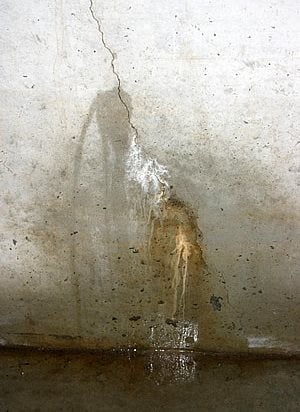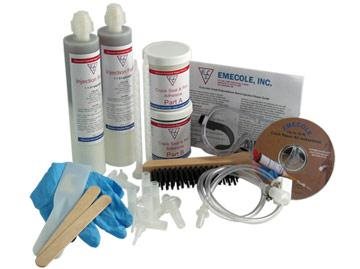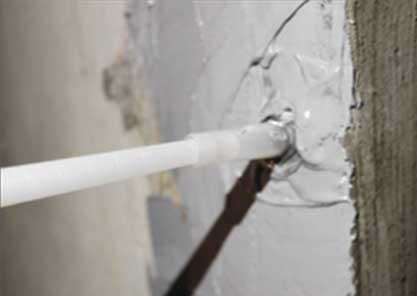How To Repair Leaking Basement Wall Cracks
Concrete Contractors: Find Epoxy and Polyurethane Products and Suppliers

While concrete cracks appear to be typical, it is not recommended that they remain ignored. About homeowners best identify concrete cracks in their basement, either on the foundation wall or on the floor. They may as well recognize cracks on the garage flooring, patio or in-ground puddle.
These cracks typically due to drying shrinkage, thermal movement or other causes normally are minor and result in few problems. More than often than not, a foundation crack volition widen over fourth dimension and result in water seepage or possibly the loss of structural integrity. Foundation and slab cracks are not only an eyesore, just they may hinder the value of the home.
Fortunately, in that location is an like shooting fish in a barrel style to permanently repair such cracks without the demand for costly and confusing excavation or drain tile. Poured foundation cracks may exist repaired by using depression-pressure injection of an epoxy or polyurethane foam fabric. For the repair of concrete floor cracks, sure epoxies and polyurea materials exists, suitable for such slab repairs.
The application of such materials may be completed by a basement waterproofing contractor or a exercise-it-yourself homeowner. Either fashion, the repair of concrete cracks in either the foundation or the slab may efficiently and effectively be completed in as little equally an hr or more.
HOW Scissure INJECTION WORKS
Most basements eventually leak. "Even if a crevice is not leaking now, eventually water will find it," says Lou Cole, president of Emecole Inc., Romeoville, Ill., a manufacturer of epoxies and polyurethane foams for all types of foundation fissure repair. Cole says that in the Midwest, crack injection has been an accepted fashion of tackling these repairs for many years, and more and more foundation repair contractors around the country are adopting the technique because it is cost-effective, reliable, and permanent.
"Emecole'south customers, primarily residential waterproofing contractors, have less than a one% callback rate for scissure repair work. More than 99% of the time, crack injection volition fix the trouble," says Cole. "Most contractors in the Chicago area (as well equally other parts of the country) warranty the injection repair for the life of the structure," he adds.
Cole launched his company in 1987, later coming up with the concept of dual-cartridge dispensing of two-component materials using a jump-assisted dispensing tool similar to a caulking gun. The awarding that seemed to show the nearly promise for his dual-cartridge organization was low-force per unit area injection of cracks in physical. That gave him the impetus to develop a line of epoxies and polyurethane foams specifically formulated for those types of repairs.
The whole purpose is to make full the crack, from front to back, with epoxy or polyurethane. "For basement walls, depression-force per unit area injection is the best mode to ensure that the crack is completely filled," Cole maintains. This method is effective for filling cracks 0.002 to 1 inch broad in walls up to 12 inches thick. It can also be used to fill cracks in concrete floors and ceilings.
EPOXIES VS. POLYURETHANES
And so which textile is better for repairing physical cracks: epoxy or polyurethane cream? The respond isn't always clear-cut. In many cases, either material tin accomplish the task, and applicators may simply choose the material they take the most experience with. Only hither are some general guidelines: If the crack needs to be structurally repaired and the area needs to be as strong or stronger than the concrete effectually it, use an epoxy. If the crack needs to be repaired but to forbid water leakage or the crack is actively leaking, a polyurethane is usually the best choice. Here's a look at the advantages and limitations of each fabric.
Epoxies
Epoxies for crack injection are available in a range of viscosities, from ultra-thin to paste-like, to accommodate cracks of different widths. Coles advice is to utilise whatever viscosity is needed to inject a given crack at pressures less than xl psi. The wider the crevice, the thicker the textile required.
The chief advantage of epoxies is their astonishing compressive strength, which at 12,000 psi or greater exceeds that of near physical. That's why epoxies are the merely choice for cracks requiring structural repair. All the same, epoxies cure very slowly, generally taking hours to harden. This tin be an reward considering it allows time for the epoxy to flow into even the smallest crevices. On the other hand, its also possible for the epoxy to flow out of the behind of the crack before information technology has hardened if the backfill outside the wall has separated from the foundation.
"Often there are voids backside cracks due to soil erosion or poor compaction," explains Cole. That's why the crack is leaking in the offset place; its easy for water to enter.
Polyurethanes
If there is business organization about cloth leaking out the back of a crack, polyurethane foams should be used. These elastomeric, fast-setting foams are effective alternatives for applications involving only cleft sealing (waterproofing) and not structural repair. Because of their elastomeric nature, they are able to accommodate slight physical motility so the seal stays intact. They likewise begin to harden and cream within minutes of injection. This reduces the chances of the material flowing out of an injected fissure while still in liquid form, and even if some does leak out, the cream will fill up the void.
"Urethanes are peachy for basic crack filling. They add practically zero compressive strength, just in most residential applications, you don't demand it," says Cole.
Concrete Contractors: Detect Epoxy and Polyurethane Products and Suppliers
DO It YOURSELF CRACK INJECTION KITS

Emecole Crevice Repair Kits are a superlative pick for pros and do-it-yourselfers.
Using depression-force per unit area scissure injection, foundation and basement crack repair kits seal basement cracks from the inside, eliminating the need to excavate the soil from effectually the outside of the foundation. The kits are available with all the tools and materials needed to treat cracks ranging from x to threescore feet in length and include pace-by-step written instructions likewise as a video tutorial.
You can choose from crack repair kits that use either an injectable polyurethane cream or an epoxy, depending on the type of cracks y'all have. Polyurethane scissure injection kits are recommended for non-structural leaking cracks resulting from concrete shrinkage or modest settlement while epoxy injection kits are designed to treat more astringent cracks that compromise the structural integrity of the wall.
Hither's how to determine which foundation crack repair kit to use:
- Determine the full length of the cleft(s) needing repair and select the appropriate kit size (ten, 30, or 60 feet).
- Determine whether you demand to repair the crack with epoxy or polyurethane foam. Utilise a polyurethane foam kit for repairing leaking non-structural cracks and an epoxy kit for repairing structural foundation cracks wider than a quarter of an inch or big areas of multiple cracks.
Bones STEPS IN THE INJECTION PROCESS

An epoxy resin is injected into the scissure via special ports. Rhino Carbon Fiber.
Here are the bones steps for successful low-pressure crevice injection. Continue in listen, even so, that the blazon of epoxy or polyurethane used and the time required for injection volition vary with each job depending on the crack width, wall thickness, and other conditions. These tin can likewise be bought as as crack repair kits that some with all the tools and supplies needed for the project.
Install injection ports: Surface Ports (brusk rigid-plastic tubes with a flat base) serve as handy entryways for getting the repair material into the scissure. They eliminate the need to drill into the concrete, reducing labor fourth dimension and cleanup. The base of the port is placed direct over the crack and bonded to the surface with an epoxy paste. A full general rule-of-pollex is to space the ports an inch apart for each inch of wall thickness.
Seal the surface: Utilize an epoxy agglutinative to seal over the surface ports and exposed cracks. The paste cures in nigh xx to 45 minutes to provide a surface seal with excellent bond characteristics that holds upwardly under injection pressures. The entire exposed scissure is covered with the paste, leaving only the port holes uncovered.
Inject the scissure: Begin injecting at the lowest port on the wall and go on until the epoxy or urethane begins to ooze out of the port above it. That'southward the visual sign that the crevice has been filled to that level. Plug the first port with the cap provided and movement upwardly to the side by side port, repeating this procedure until the entire crack has been filled with epoxy or urethane. Let the compression spring on the dispensing tool push the textile into the crevice using slow, constant force per unit area. This volition reduce the possibility of leaks or accident-outs and allow time for the repair material to fully penetrate the crack.
Remove the ports: Allow 24 to 48 hours at room temperature for the epoxy or polyurethane to cure and penetrate into the cracks. The injection ports can then be removed by striking them with a trowel or hammer. If advent is an event, the epoxy surface seal can be chipped away or footing off with a sanding disk. Another option is to use a surface seal that can just be peeled off the wall later the repair is fully cured.
DIY Crevice Repair Kits for homeowners
WHY LOW-Force per unit area INJECTION?
The undercover to effective crevice injection, whether using epoxies or polyurethane foams, is gradual introduction of the liquid polymer into the cleft at low pressures (20 to 40 psi). This method requires some patience, but it allows the applicator to monitor the injection process and ensure that the crack is completely filled. Incomplete injection of a crack is the well-nigh common reason for crack repair failure.
To fill up a typical fissure in a residential foundation wall, injecting at pressures above xl psi may non be effective. At higher pressures, the liquid has enough strength to overcome gravity and ascent up the scissure without filling the behind, which is typically narrower than the forepart of the crack. High-pressure injection is better suited for repairing cracks in very thick-walled structures or where a loftier volume of water flow must be stopped (such as dam repairs).
Concrete Repair and Troubleshooting
ADVANTAGES OF DUAL-CARTRIDGE DISPENSING
Dual-cartridge dispensing, using dispensable or reusable cartridges or containers, is a toll-effective completely portable method of injecting two-component polymers. The equipment also requires minimal maintenance and virtually no cleanup. At the end of the day, you simply discard the spent cartridges or reseal a partially used cartridge for reuse on some other task. Each cartridge contains 16 to 22 ounces of fabric.
Automatic proportioning equipment that dispenses bulk quantities of cloth also is available and may exist the best selection on jobs requiring higher injection pressures or large volumes of material. Just this equipment is expensive and cumbersome, and typically overkill for smaller residential jobs requiring only a few gallons of epoxy.
A jump-assisted dispensing tool allows complete command of injection pressures to keep them between twenty to 40 psithe best range for complete cleft filling. The user simply changes the spring tension to accommodate the forcefulness generated. Transmission tools using a bulldoze rod rather than a leap are difficult to control and may issue in injecting at pressures much higher than desired. Air-powered tools are too available for dual-cartridge dispensing and let control of injection pressure.
Because the epoxies and polyurethane foams used for crack injection are two-component materials, it is critical to mix them at the correct ratios to avoid problems with unreacted polymers. The dual-cartridge dispenser as well acts every bit a proportioning device past using a static mixer, available in diverse sizes, to accurately mix the two components.
"The cartridges and static mixer eliminate a lot of bug," says Cole. "Y'all don't accept to exist a pharmacist onsite. You just put the static mixer on the dispensing tool to achieve the right ratio and to properly mix the two components."
LIMITATIONS OF LOW-PRESSURE INJECTION
Low-force per unit area injection is ideal for fixing cracks in virtually poured-in-place residential basements. Only in some cases you may need to pursue other remedial measures, along with crack sealing, to guarantee a complete fix.
If the foundation has settled due to compressible or improperly compacted soil, poor drainage, or uneven moisture atmospheric condition, use of hydraulically driven piles or piers may exist required to lift the foundation and prevent future settlement. However, piering won't seal existing cracks, which may however need to be injected to prevent leaks after the foundation has been stabilized.
Similarly, cleft injection can work hand in hand with carbon cobweb reinforcement to stabilize and reinforce poured foundation basement walls that have bowed and cracked. "We oftentimes recommend the employ of carbon fiber stitching in conjunction with crack injection repairs," says Cole. "It's better than stitching the scissure with rebar and improves the chances that the crack will not reopen if there'southward ongoing, unforeseeable move of the wall."
Cole says that crack injection is not a solution for fixing cracks in masonry cake foundation walls. It also tin't be used if h2o is leaking from a crack betwixt the seam of the wall and the slab, which indicates a water table problem.
Allowable scissure widths
Featured Products
Source: https://www.concretenetwork.com/concrete/crack_injection/epoxies_vs_polyurethanes.html
Posted by: reuterwroke1951.blogspot.com


0 Response to "How To Repair Leaking Basement Wall Cracks"
Post a Comment